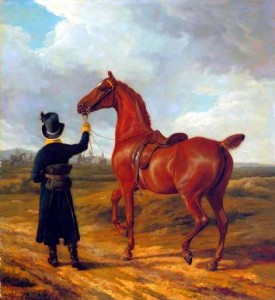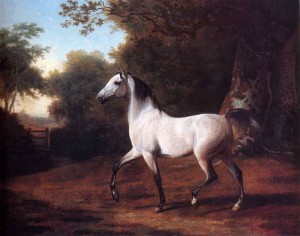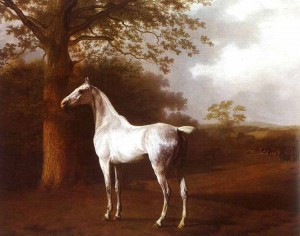Jacques-Laurent Agasse for Thursday Art-Day
I have become quite addicted to the artists of the 1700 and 1800’s, their art not only reminds us of their slower pace of life but it also speaks of their ability to REALLY see the beauty around them…
A grey Arab
Jacques-Laurent Agasse (April 24, 1767 – December 27, 1849) was an animal and landscape painter from Switzerland.
Adapted from Wikipedia, the free encyclopaedia www.en.wikipedia.org and Lane Fine Art www.lanefineart.com
Jacques Laurent Agasse could be noted as the most accomplished painter of animals that Switzerland has ever produced. Born at Geneva, on 24th March 1767, he enjoyed a happy childhood spending time between his town and country family homes. It’s said he loved animals frequenting the stables, kennels and farm-yard. After discovering an edition of Buffon’s Natural History, he began to draw pictures of animals, and he rapidly became proficient. His father enrolled him in the Calabri Academy of Drawing in 1782, where he struck up friendships with Firmin Massot and Adam Toepffer, often collaborating a number of paintings with them. Before he turned twenty he went to Paris to study in veterinary school to make himself fully acquainted with the anatomy of horses and other animals. It is a tribute to his quality as an artist that many of his paintings have erroneously been attributed to George Stubbs, the only other painter of the Georgian era who matches or surpasses his achievements.

Lord Rivers Chestnut
From 1786-9 he moved to Paris where he worked as a pupil and assistant in David’s studio but his time in Paris was brought to a close by the onset of the French Revolution. Back in Geneva, he met (1789) and was encouraged by the aesthete, courtier and sportsman George Pitt, later Lord Rivers, who advised him to try to earn his fortune in England. He stayed in Switzerland, though, for another decade, before arriving in England, via a second stay in Paris, in 1800. Here he stayed with the family of his Genevan friends the Chalons, who had established themselves as successful artists in London. In the following year he exhibited his first painting at the Royal Academy, a pattern which repeated itself throughout his long (49 years) stay in London. He seems to have subsequently returned to Switzerland. The Tübinger Morgenblatt (1808, p. 876) says that “Agasse, the celebrated animal painter, now in England, owed his fortune to an accident. About eight years ago, he being then in Switzerland, a rich Englishman asked him to paint his favourite dog which had died. The Englishman was so pleased with his work that he took the painter to England with him.”
Rolla and Portia
Agasse’s life in London was marked by a great success as an animal painter, and his patrons included such luminaries as Lords Wellesley and Rivers, the Royal Collection and many other grand landed families. He made something of a speciality in painting exotic animals, and was a frequent visitor to the menageries which were a feature of London life at this date. He lived in London for the last 50 years of his life. His paintings are of the utmost technical refinement and delicacy, and are superbly observed and drawn. He died on 17th December 1849 and was buried in St. John’s Wood.
White Horse
Nagler says that he was one of the most celebrated animal painters at the end of the 18th and the beginning of the 19th century. In Meusel’s Neue Miscellaneen (viii. 1052 et seq.), he compares Agasse and Wouvermans, wholly in favour of the former. In that partial article much is said of his extreme devotion to art, of his marvellous knowledge of anatomy, of his special fondness for the English racehorses, and his excellence in depicting them. He appears first in the Academy catalogues in 1801 as the exhibitor of the ‘Portrait of a Horse’, and continued to exhibit more or less until 1845 (contradicting Nagler’s statement that he died “about” 1806). In the catalogues his name is given as J.L. Agasse or Agassé. The number of times Agassé changed his address confirms Redgrave’s assertion that “he lived poor and died poor”. The writer of the panegyric already quoted says, however, that he did not work for money, but that he was urged forward by the resistless force of natural genius.



Leave a Reply